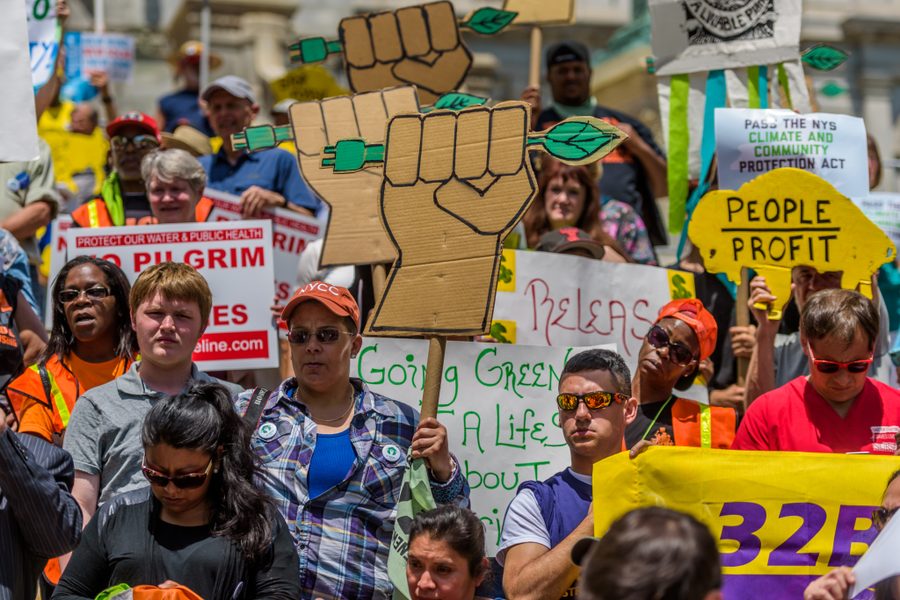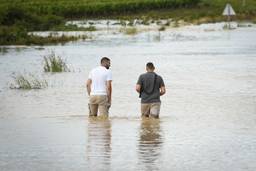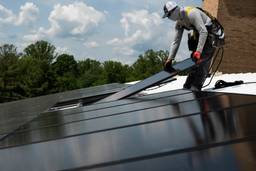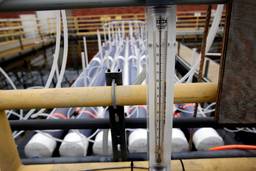
Several years before Rep. Alexandria Ocasio-Cortez (D-N.Y.) elevated the climate, jobs and justice framework to the national level, a coalition of labor, environmental and community groups joined together to push for a pioneering climate bill in New York.
The idea for the legislation came in the immediate aftermath of the 2014 People’s Climate March, when organizers decided to build on the momentum of the historic demonstration. In 2016 the Climate and Community Protection Act (CCPA) was born, an expansive bill that would require New York to generate half of its electricity from renewable sources by 2030, and eliminate all greenhouse gas emissions by 2050. The bill would also mandate that 40 percent of New York’s climate funding go towards projects in low-income, vulnerable communities, and require all green projects to have high labor standards, including the requirement for a prevailing wage.
“It’s among the most aggressive decarbonization proposals in the nation,” said Arielle Swernoff, the communications coordinator for New York Renews, a coalition of over 170 state groups backing the legislation. “The only state that has really done something comparable is Hawaii.”
New York Renews offers an encouraging example of how labor and environmental groups can work together to act on climate change. The coalition has the backing of unions like 32BJ Service Employees International Union — a property service workers union, the New York State Nurses Association, the New York State Amalgamated Transit Union, Teamsters Joint Council 16 and the Communications Workers of America Local 1108. It also has the support of a vast number of environmental groups, including the Sierra Club, Environmental Advocates of New York and GreenFaith.
The bill’s strong language around labor — such as requiring that government contracts include mechanisms for resolving disputes and ensuring labor harmony — has helped quell opposition from building trade unions that typically fight robust climate proposals. The New York AFL-CIO, a labor federation representing 3,000 state affiliates, has notably stayed quiet on the bill.
Nella Pineda-Marcon, the chair of the Climate Justice and Disaster Relief committee with the New York State Nurses Association, told In These Times that it was an easy decision for her union to back the CCPA. Her union, which represents 43,000 nurses statewide, got very involved with the climate crisis following Hurricane Sandy in 2012. The following year, Pineda-Marcon traveled to the Philippines as a first-responder to Typhoon Haiyan. “We are on the front lines of this crisis, we see first-hand the destruction it has,” she explained. “And the massive amounts of pollutants in our air are driving up rates of chronic asthma in our most vulnerable communities… We need to lead now and the rest of the world can follow us.”
The politics of the CCPA are coming to a head as the deadline for passage ends June 19. The bill passed the state Assembly in 2016, 2017 and 2018 — and last year a majority of state senators signed on in support. But the Senate Leader never allowed it to come to the floor for a vote. After the 2018 midterms, however, when progressive Democrats ousted a group of centrists who often caucused with Republicans, advocates felt the stars were aligning more favorably for the CCPA’s passage this year.
Indeed, in January the new Senate Majority Leader Andrea Stewart-Cousins released a statement calling the CCPA “the main vehicle through which we will address climate change.” The state senate held its first-ever hearing on climate change in February, led by Sen. Todd Kaminsky (D), the new Environmental Conservation Committee chairman.
Various scientists testified, including Mathias Vuille, a professor of climate and atmospheric sciences at the University of Albany and a member of the Intergovernmental Panel on Climate Change. Vuille explained that the most significant impact resulting from a changing climate in New York so far has been the rise of intense storms, which have increased in frequency in the Northeast more than any other region in the United States. Sea levels along the mid-Atlantic and New England coasts have also risen much higher than the global average, he said, pointing to a rise in New York sea levels by 280 millimeters over the 20th century, compared to a global average increase of 170 millimeters.
While Vuille cautioned that he’s neither a renewable energy specialist nor an economist, he said “we owe it to future generations” to continue leading the transition off fossil fuels, and emphasized a need to reduce emissions in the transportation sector in particular. “I think this can be done if we really have the will,” he said.
Some labor advocates, like Mike Gendron, the executive vice president of Communications Workers of America Local 1108, also testified in support of the CCPA. “As we transition from fossil fuel based energy to renewable energy, we must make sure that the jobs created, are good paying union jobs with proper training, for both new workers and transitioning workers,” he said. “The New York State Climate and Community Protection Act will help make that happen.”
Other unions offered more qualified support, endorsing specific sections of the legislation. Ellen Redmond, representing the International Brotherhood of Electrical Workers (IBEW), testified that her union does in fact believe the CCPA contains commendable language around workers’ rights. “We do believe the labor protections are strong,” she said, though suggested it could be even better if there were more teeth and real dollars behind it. IBEW represents about 50,000 members in New York, many of whom work in the utilities industry.
Mark Brueggenjohann, a spokesperson for the IBEW, told In These Times that his union didn’t have anything new to add to Redmond’s February testimony and doesn’t “anticipate any further statements” this month.
State senators also heard from industry groups that raised concerns, like Mitch Paley, testifying on behalf of the New York State Builders Association. Paley said while his colleagues support some aspects of the CCPA, they object to the prevailing wage requirements which would, by their own estimate, increase residential projects by 35 to 45%. The mandated solar requirements for new homes, he added, could increase the cost of each project by $10,000. This would “dramatically affect the ability to promote affordable homes in our region,” he argued.
Darren Suarez, the senior director of government affairs for the Business Council of New York State testified against the bill, arguing that the proposed legislation would “increase energy costs, operational costs, and create uncertainty, compromising the global competitiveness of energy-intensive, trade-exposed industries.” He insisted the bill’s goals are not practical, and that the manufacturing sector should be included in developing the state’s climate policies.
A study by the Political Economy Research Institute at the University of Massachusetts - Amherst found that New York transitioning to a 100 percent renewable economy could support 160,000 direct and indirect jobs initially and an average of about 150,000 in each year over the first decade. The institute also estimates that New York’s fossil fuel workforce is relatively small, comprised of roughly 13,000 individuals, out of a statewide workforce of around 9 million.
A threatening factor for CCPA supporters is that the state’s governor, Andrew Cuomo, has introduced his own more moderate climate bill—the Climate Leadership Act. His legislation calls for the electricity sector to be carbon-free by 2040, but does not lay out a concrete plan for other sectors that emit greenhouse gas, like transportation. The two bills are dividing Democrats in Albany. Advocates for CCPA say Cuomo’s bill does not go far enough, and it’s imperative to legislate specific climate goals, so they are not “at the whim of the executive” anymore.
Swernoff of New York Renews says the governor’s office has expressed discomfort specifically with the prevailing wage standard for all green projects, the 40% investment into vulnerable and low-income communities, and setting a timeline for the whole economy, as opposed to just for electricity.
New York federal legislators are ramping up pressure on state lawmakers to pass the CCPA. On June 4, eleven Congressional representatives from New York, including Reps. Ocasio-Cortez and Nydia Velázquez, sent a letter in support of the bill. “We believe the people-led Climate and Community Protection Act before you in Albany presents…an opportunity for New York,” they wrote. “An opportunity to cure the injustices of the past and to secure, with intent, a just transition into the future.” On June 5, New York senator Kirsten Gillibrand sent her own letter in support of the bill.
Maritza Silva-Farrell, executive director of ALIGN, a steering committee member of New York Renews and the New York affiliate of Jobs with Justice, said she knows lawmakers are taking the CCPA very seriously right now, and she’s “hopeful this year its passage will become a reality.”
When it comes to the governor signing the bill, Silva-Farrell says she is less sure. “You never know where he’s going to be on an issue,” she said. “But one thing that is very clear is that if he wants to leave a strong legacy for his family, for his kids, and his grandkids, he should get behind this.”







